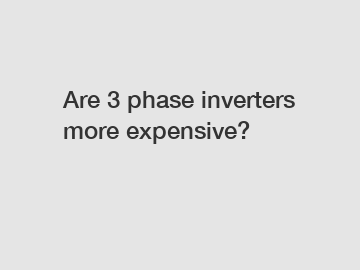Are 3 phase inverters more expensive?
When it comes to choosing the right inverter for your power system, one question that often comes up is whether 3-phase inverters are more expensive than their single-phase counterparts. The answer to this question is not as straightforward as it may seem, as there are several factors that can influence the cost of a 3-phase inverter. In this blog post, we will explore some of these factors and help you understand why 3-phase inverters can sometimes be more expensive.
To start off, it is important to understand the difference between single-phase and 3-phase power systems. In a single-phase system, all the electrical devices are powered by a single alternating current (AC) waveform. This type of system is commonly used in residential and small commercial applications. On the other hand, a 3-phase power system utilizes three separate AC waveforms that are 120 degrees out of phase with each other. This type of system is commonly used in larger commercial and industrial applications.
One of the main reasons why 3-phase inverters can be more expensive is because they are designed to handle higher power loads than single-phase inverters. This means that the components used in 3-phase inverters need to be of higher quality and able to withstand higher levels of stress. In addition, 3-phase inverters also require more complex control systems to ensure that the three separate AC waveforms are synchronized and balanced. This extra complexity can add to the overall cost of the inverter.

Another factor that can contribute to the cost of 3-phase inverters is the size of the system. In general, 3-phase power systems are larger and more powerful than single-phase systems, which means that the inverters used in these systems also need to be larger and more powerful. This can result in higher manufacturing costs and ultimately a higher price tag for the consumer.
Furthermore, the demand for 3-phase inverters is typically lower than that for single-phase inverters. This means that manufacturers may not be able to benefit from economies of scale when producing 3-phase inverters, which can drive up the cost of production. Additionally, the market for 3-phase inverters is more specialized and limited, which can also contribute to the higher cost.
Despite these factors, it is important to note that the cost of 3-phase inverters is not always higher than that of single-phase inverters. In some cases, the cost difference may be minimal or even non-existent, especially if you are comparing inverters of similar quality and capacity. Additionally, the benefits of using a 3-phase power system - such as improved efficiency, power quality, and reliability - can often justify the higher cost of a 3-phase inverter.
In conclusion, while 3-phase inverters can sometimes be more expensive than single-phase inverters, this is not always the case. The cost of a 3-phase inverter can be influenced by several factors, including the size and complexity of the system, the demand for 3-phase inverters, and the quality of the components used. Ultimately, the decision to choose a 3-phase inverter should be based on your specific power needs and requirements, as well as the long-term benefits that a 3-phase power system can provide.
The company is the world’s best three phase inverter for industrial solar applications, inverter for 5kw solar system, energy security hybrid storage inverter supplier. We are your one-stop shop for all needs. Our staff are highly-specialized and will help you find the product you need.


